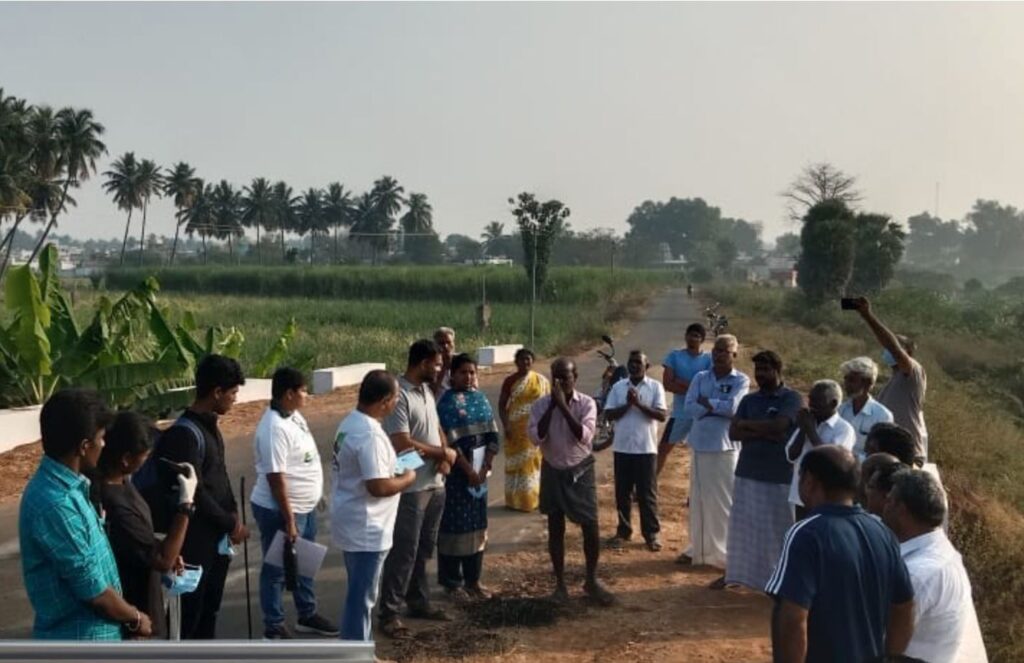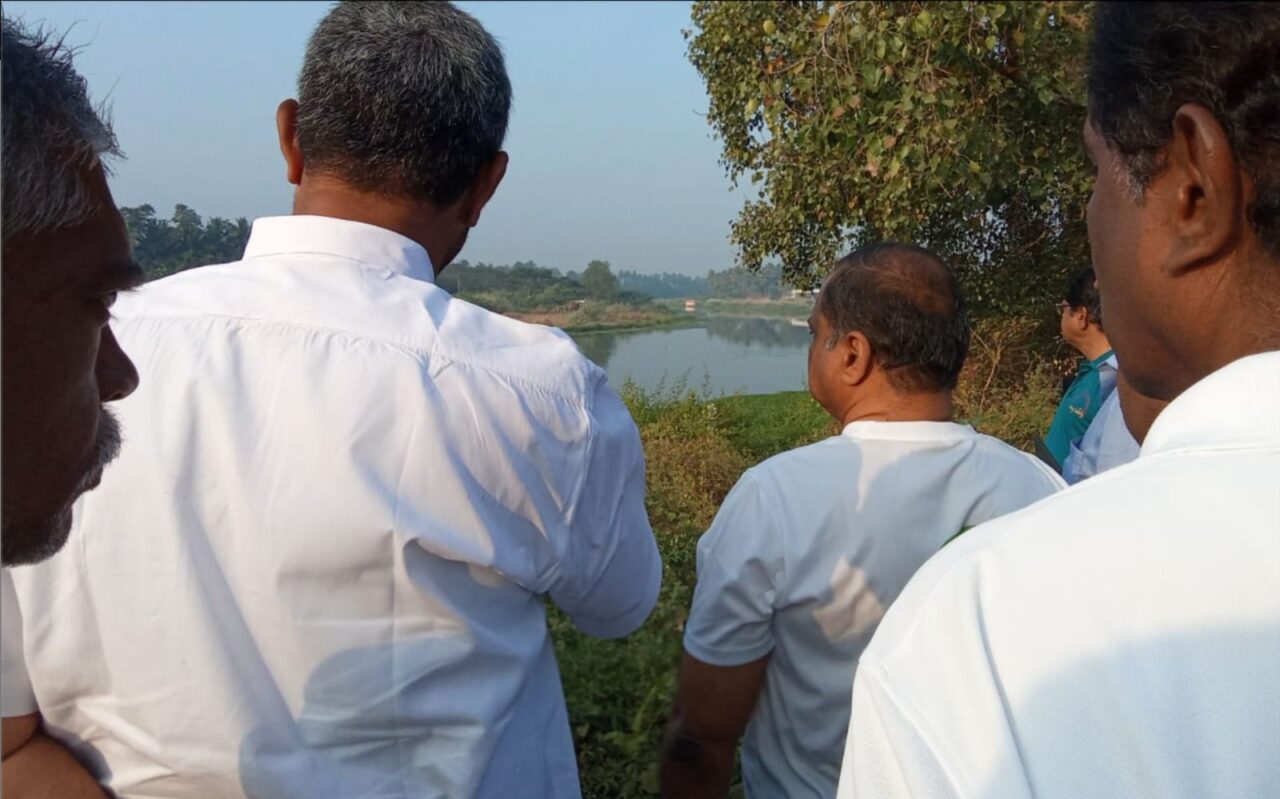by Dr. Mina Venkataraman, ESRAG lead for Community Action for Fresh Water
Urgent Call for Action: How Rotary’s Global Network is Protecting Freshwater Resources Amid Climate Crisis
Community Action for Freshwater (CAFW), Rotary’s new partnership with the United Nations Environment Programme (UNEP), was launched at the International Assembly in January 2024. The vital resource Rotary brings to this collaboration is our grassroots network of clubs on six continents. CAFW is a call to clubs and districts to take action for freshwater bodies in their region, and to map their service as part of an global quest to restore and protect the freshwater supplies on which our lives and economies depend. You can register your project at this link.

Rotarians on Transect Walt
I’ll give an example of how the Rotary Club of Bhavani Koodal is working to protect the River Bhavani, but first, here’s why it is urgent for Rotarians to mobilize our communities. Freshwater is a diminishing resource. As climate change affects ocean currents and intensifies extreme weather events, rainfall has been erratic. The rapid melting of glaciers and heavy rainfall events are causing massive floods and erosion, devastating huge areas of farmland and infrastructure and depriving our reservoirs and aquifers of the steady replenishment that slower glacial melting provided. The world was shocked to see this lethal dynamic – glacial melting plus record-shattering monsoons – in the Pakistan floods of 2022.
Saving our freshwater resources requires a concerted effort. ESRAG members are the advocates in promoting Community Action for Fresh Water in their districts and getting clubs to sign up for any activity that protects a freshwater body. Here are some examples:
- Advocacy for clean lakes or ponds
- Creating ponds
- Removing invasive species from dry riverbeds, streams, or ponds
- De-silting
- Building check dams or bund protection
- Creating bunds for streams
- Carrying out afforestation along water bodies
- Organizing plastic and waste removal drives, and
- Creating different types of barriers to stop plastics from entering the oceans.
Other activities include clearing up wetland ecosystems and springs, estuaries bearing mangroves, and intertidal zones. Your club can contribute to increasing biodiversity around the freshwater bodies which host endemic species and are crucial breeding spots for fishes like salmon, trout, and migratory birds.
What does Community Action for Fresh Water, CAFW, entail?
What are we expecting our clubs and club members to do? If you look at the CAFW guidelines, one of the important activities is community assessment. To illustrate how this works, I’m going to use the community assessment of Jambai, conducted by the Rotary Club of Bhavani Koodal, Rotary International District, RID, 3203 from February to June 2024 as an example.

Community Focus group about Freshwater
A transect walk (preliminary survey) was taken by members of the Rotary Club of Bhavani Koodal along with ESRAG volunteers led by Rotarian (Rtn) Sivabal, then co-chair ESRAG South Asia. They walked through the village with a few members from the panchayat (local government body) to assess the access to the River Bhavani and its environs. The next step was asking the community to come together in the community hall at the local government office for a meeting which was advertised by pamphlets posted around the village.
At this meeting, people were advised that the Rotarians were there to understand how the villagers used the water resources from the river and what infrastructural or social issues they faced with respect to the river.
The main issues that came up were the lack of public toilets for women, the need for proper access to the river, better solutions for garbage, and the question of whether street lights, tree planting, or a park could be done for the region. The Rotary Club had already constructed a toilet block for the primary school using District funds.
A focus group meeting with local government leaders, teachers, and a few other people from the village was organised as a walk to address the larger issues brought up and spotlight what the Rotarians had observed in their transect walk.
On June 29, 2024 a second meeting was convened with the focus group. Under the leadership of Rtn Booma Mahendravarman, ESRAG member and district liaison for RID 3203, a resource map was drawn up with the help of the local government officials and the public.
With Rotarians’ input, the main problem areas were earmarked. The focus group were more concerned about the school premises and park, lighting, and the creation of toilets. The Rotarians added their concern about an abattoir 200 meters from the river and a laundry unit directly on the river.

Toilet Block to be renovated
The design of the community assessment now weaves together the community issues and the Rotarians’ views on the precedence of addressing issues in the conservation of the local waterbody. The consensus right now is the Rotary Club will apply for a global grant to make sure the laundry facilities are moved, provide sustainable solar pumping of water, and provide water filtration to reduce pollution from runoff.
Other issues and goals include better disposal of abattoir waste and installing a solar refrigerator for unsold meat. The Club and the community are exploring the creation of a butterfly and vegetable garden for the school, building toilet blocks for women, and installing street lights for safety. This example shows how intertwined human needs are with biodiversity. We are awaiting the start of the global grant process.
Mina Venkataraman, PhD is an ecologist and current ESRAG Projects Chair who served as an ESRAG Director from 2021-24. She has represented ESRAG at multiple conferences – including COP 28 and Rotary Zone Conferences in the Middle East and South Asia – and serves on The Rotary Foundation Cadre for the Environment.

